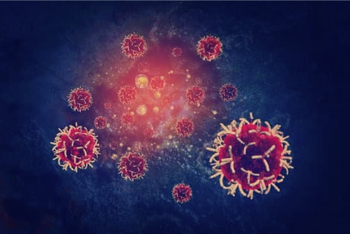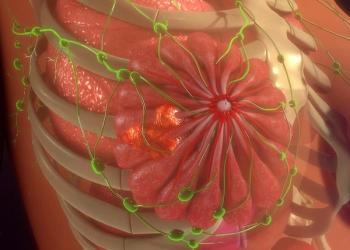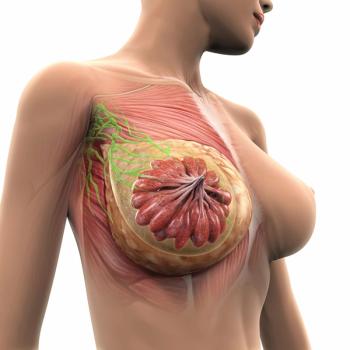
Oncology NEWS International
- Oncology NEWS International Vol 8 No 10
- Volume 8
- Issue 10
Herceptin + IL-2 Active in HER2-Overexpressing Breast Cancer
ATLANTA-“Herceptin combined with interleukin 2 (IL-2) is an active, well-tolerated regimen that has produced a clinical response in 4 of 25 breast cancer patients,” said Gini Fleming, MD, assistant professor of clinical medicine, Hematology/Oncology Section, University of Chicago Pritzker School of Medicine.
ATLANTAHerceptin combined with interleukin 2 (IL-2) is an active, well-tolerated regimen that has produced a clinical response in 4 of 25 breast cancer patients, said Gini Fleming, MD, assistant professor of clinical medicine, Hematology/Oncology Section, University of Chicago Pritzker School of Medicine.
In vitro studies have shown that Herceptin (trastuzumab), a humanized anti-HER2 monoclonal antibody, participates in antibody-dependent cellular cytotoxicity, Dr. Fleming said at the 35th annual meeting of the American Society of Clinical Oncology (ASCO) on behalf of the Cancer and Leukemia Group B (CALGB). Natural killer cells may express Fc-gamma receptors and also participate in antibody-dependent cellular cytotoxicity, she said.
Since 10% of natural killer cells naturally express a high-affinity receptor and an intermediate-affinity receptor for IL-2, low doses of the agent can expand the number of natural killer cells via the high-affinity receptor. Higher doses of IL-2 may also engage intermediate-affinity receptors and stimulate cytotoxicity, Dr. Fleming said.
For this phase I study to determine Herceptin toxicity when given with IL-2, the CALGB chose low-dose plus pulsed intermediate-dose IL-2. A phase I study in 1998 showed this schedule to result in in vivo expansion and potential activation of natural killer cells.
Patients received daily, low-dose IL-2 plus intermediate-dose pulses of IL-2 for 3 days every 2 weeks given subcutaneously. Herceptin was given intravenously every 2 weeks prior to the IL-2 pulses, with Herceptin doses escalated in successive cohorts of at least six patients.
The study included 25 breast cancer patients ; all were heavily pretreated, and all had tumors receptive to Herceptin treatment. Four additional subjects with HER2-overexpressing tumors of the lung, ovary, or head/neck were included as well.
The starting Herceptin doses for four groups of patients were 1, 2, 4, and 8 mg/kg. The protocol required that the sixth patient in a group must have been on the groups dose level for at least 30 days before the group moved to the next dose level. The number of treatment cycles ranged from 1 to 14, with a median of 4 per patient. Patients had a median of three prior chemotherapy regimens, and 11 had been transplanted.
Dr. Fleming reported that partial or complete responses occurred with the higher doses; the most effective Herceptin doses were 4 or 8 mg/kg every 2 weeks. None of the non-breast-cancer subjects responded to the regimen, she said.
The initial planned dosages of IL-2 were 1.25 million IU/m²/d plus intermediate doses of 15 million IU/m² for 3 days every 2 weeks. Side effects, however, forced most of the first 18 patients to drop out or take reduced doses, Dr. Fleming said.
Starting IL-2 Doses Reduced
As a consequence, researchers amended the starting low IL-2 dose to 1 million IU/m² and the intermediate dose to 12 million IU/m². Among 12 patients treated at those doses, IL-2 toxicities from the intermediate dose caused study removal or dose reduction for three patients: one each had hypoxia, rigors, or nausea/vomiting. With the low dose, one patient had neutropenia. Dr. Fleming attributed all hematologic toxicities primarily to low-dose IL-2.
Researchers measured in vitro cytotoxicity by analyzing patients plasma, target cell lines, and peripheral blood mononuclear cells. The only treatment-limiting toxicity attributed to Herceptin was one incident of neck pain and dyspnea at the 4 mg dose, Dr. Fleming noted. In the final dosing regimen, dyspnea occurred sporadically. Dr. Fleming observed that it may be likely to occur in patients with lung tumor involvement.
Summarizing the results, Dr. Fleming stated: This regimen can produce an increase in the percentage of peripheral blood mononuclear cells, which are natural killer cells.
Articles in this issue
about 26 years ago
Henderson Offers ‘Take-Home Messages’ From Endocrine Studiesabout 26 years ago
Sustained-Release Cytarabine for Lymphomatous Meningitisabout 26 years ago
Scintimammography Detects Tumors in Dense Breast Tissueabout 26 years ago
Autologous Vaccine as Adjuvant Therapy for Melanomaabout 26 years ago
Breast Cancer Screening in Women 40 to 49about 26 years ago
Limited Surgery Better in Colon Cancer With Diffuse Liver Metsabout 26 years ago
Risk Factors for Local Recurrence After Breast-Conserving Therapyabout 26 years ago
New Brain Imaging Technique Cuts MR Scan Time in Halfabout 26 years ago
NCI Is Testing Thalidomide to Prevent Colorectal Cancer Recurrenceabout 26 years ago
Penn Cancer Center Sponsors Exhibit of Cancer Patients’ ArtNewsletter
Stay up to date on recent advances in the multidisciplinary approach to cancer.



















































































